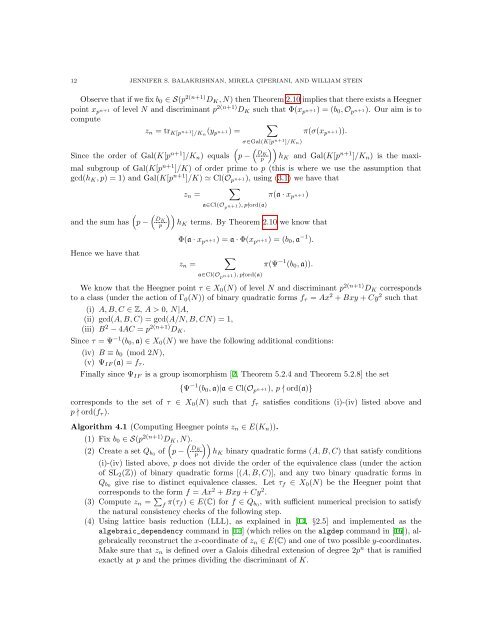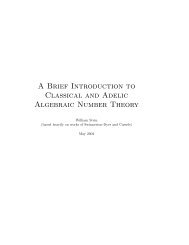p-ADIC HEIGHTS OF HEEGNER POINTS AND ANTICYCLOTOMIC ...
p-ADIC HEIGHTS OF HEEGNER POINTS AND ANTICYCLOTOMIC ...
p-ADIC HEIGHTS OF HEEGNER POINTS AND ANTICYCLOTOMIC ...
You also want an ePaper? Increase the reach of your titles
YUMPU automatically turns print PDFs into web optimized ePapers that Google loves.
12 JENNIFER S. BALAKRISHNAN, MIRELA ÇIPERIANI, <strong>AND</strong> WILLIAM STEIN<br />
Observe that if we fix b0 ∈ S(p 2(n+1) DK, N) then Theorem 2.10 implies that there exists a Heegner<br />
point x p n+1 of level N and discriminant p 2(n+1) DK such that Φ(x p n+1) = (b0, O p n+1). Our aim is to<br />
compute<br />
zn = tr K[p n+1 ]/Kn (y p n+1) =<br />
Since the order of Gal(K[p n+1 ]/Kn) equals<br />
<br />
σ∈Gal(K[p n+1 ]/Kn)<br />
<br />
p −<br />
DK<br />
p<br />
<br />
π(σ(x p n+1)).<br />
hK and Gal(K[p n+1 ]/Kn) is the maxi-<br />
mal subgroup of Gal(K[pn+1 ]/K) of order prime to p (this is where we use the assumption that<br />
gcd(hK, p) = 1) and Gal(K[pn+1 ]/K) Cl(Opn+1), using (3.1) we have that<br />
<br />
zn =<br />
π(a · xpn+1) and the sum has<br />
Hence we have that<br />
<br />
p −<br />
a∈Cl(O p n+1 ), p∤ord(a)<br />
<br />
DK<br />
p<br />
hK terms. By Theorem 2.10 we know that<br />
Φ(a · x p n+1) = a · Φ(x p n+1) = (b0, a −1 ).<br />
zn =<br />
<br />
a∈Cl(O p n+1 ), p∤ord(a)<br />
π(Ψ −1 (b0, a)).<br />
We know that the Heegner point τ ∈ X0(N) of level N and discriminant p 2(n+1) DK corresponds<br />
to a class (under the action of Γ0(N)) of binary quadratic forms fτ = Ax 2 + Bxy + Cy 2 such that<br />
(i) A, B, C ∈ Z, A > 0, N|A,<br />
(ii) gcd(A, B, C) = gcd(A/N, B, CN) = 1,<br />
(iii) B 2 − 4AC = p 2(n+1) DK.<br />
Since τ = Ψ −1 (b0, a) ∈ X0(N) we have the following additional conditions:<br />
(iv) B ≡ b0 (mod 2N),<br />
(v) ΨIF (a) = fτ .<br />
Finally since ΨIF is a group isomorphism [2, Theorem 5.2.4 and Theorem 5.2.8] the set<br />
{Ψ −1 (b0, a)|a ∈ Cl(O p n+1), p ∤ ord(a)}<br />
corresponds to the set of τ ∈ X0(N) such that fτ satisfies conditions (i)-(iv) listed above and<br />
p ∤ ord(fτ ).<br />
Algorithm 4.1 (Computing Heegner points zn ∈ E(Kn)).<br />
(1) Fix b0 ∈ S(p 2(n+1) DK, N).<br />
(2) Create a set Qb0 of<br />
<br />
p −<br />
DK<br />
p<br />
<br />
hK binary quadratic forms (A, B, C) that satisfy conditions<br />
(i)-(iv) listed above, p does not divide the order of the equivalence class (under the action<br />
of SL2(Z)) of binary quadratic forms [(A, B, C)], and any two binary quadratic forms in<br />
Qb0 give rise to distinct equivalence classes. Let τf ∈ X0(N) be the Heegner point that<br />
corresponds to the form f = Ax 2 + Bxy + Cy 2 .<br />
(3) Compute zn = <br />
f π(τf ) ∈ E(C) for f ∈ Qb0 , with sufficient numerical precision to satisfy<br />
the natural consistency checks of the following step.<br />
(4) Using lattice basis reduction (LLL), as explained in [14, §2.5] and implemented as the<br />
algebraic_dependency command in [15] (which relies on the algdep command in [16]), algebraically<br />
reconstruct the x-coordinate of zn ∈ E(C) and one of two possible y-coordinates.<br />
Make sure that zn is defined over a Galois dihedral extension of degree 2pn that is ramified<br />
exactly at p and the primes dividing the discriminant of K.
















